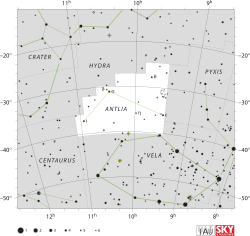Eta Antliae

| |
| Observation data Epoch J2000.0 Equinox J2000.0 | |
|---|---|
| Constellation | Antlia |
| Right ascension | 09h 58m 52.27556s[1] |
| Declination | –35° 53′ 27.5098″[1] |
| Apparent magnitude (V) | 5.222[2] |
| Characteristics | |
| Spectral type | F1 V[3] |
| U−B color index | +0.068[2] |
| B−V color index | +0.333[2] |
| Astrometry | |
| Radial velocity (Rv) | +30[4] km/s |
| Proper motion (μ) | RA: –89.65[1] mas/yr Dec.: –17.23[1] mas/yr |
| Parallax (π) | 30.02 ± 0.24[1] mas |
| Distance | 108.6 ± 0.9 ly (33.3 ± 0.3 pc) |
| Details | |
| η Ant A | |
| Mass | 1.55[5] M☉ |
| Luminosity | 6.6[5] L☉ |
| Surface gravity (log g) | 3.94[3] cgs |
| Temperature | 7,132[3] K |
| Metallicity [Fe/H] | –0.20[3] dex |
| Age | 0.9[5] Gyr |
| Other designations | |
| Database references | |
| SIMBAD | data |
| Database references | |
| SIMBAD | data |
Eta Antliae (η Ant, η Antliae) is the Bayer designation for a double star in the southern constellation of Antlia. The brighter component has an apparent visual magnitude of 5.222,[2] making it visible to the naked eye. Parallax measurements of the system yield a distance estimate of 108.6 light-years (33.3 parsecs) from Earth.[1]
The main component has a stellar classification of F1 V,[3] which indicates that it is an F-type main sequence star. This star has 55% more mass than the Sun.[5] It shines with 6.6[5] times the Sun's luminosity at an effective temperature of 7,132 K.[3] This heat gives it the yellow-white glow of an F-type star.[7] It has a faint companion located 31 arcseconds away with an apparent magnitude of +11.3. Most likely this pair form a binary star system.[8]
References
- ↑ 1.0 1.1 1.2 1.3 1.4 1.5 van Leeuwen, F. (November 2007), "Validation of the new Hipparcos reduction", Astronomy and Astrophysics 474 (2): 653–664, arXiv:0708.1752, Bibcode:2007A&A...474..653V, doi:10.1051/0004-6361:20078357.
- ↑ 2.0 2.1 2.2 2.3 Gutierrez-Moreno, Adelina et al. (1966), A System of photometric standards 1, Publicaciones Universidad de Chile, Department de Astronomy, pp. 1–17, Bibcode:1966PDAUC...1....1G.
- ↑ 3.0 3.1 3.2 3.3 3.4 3.5 Gray, R. O. et al. (July 2006), "Contributions to the Nearby Stars (NStars) Project: spectroscopy of stars earlier than M0 within 40 pc-The Southern Sample", The Astronomical Journal 132 (1): 161–170, arXiv:astro-ph/0603770, Bibcode:2006AJ....132..161G, doi:10.1086/504637.
- ↑ Wilson, Ralph Elmer (1953), General Catalogue of Stellar Radial Velocities, Washington: Carnegie Institution of Washington, Bibcode:1953QB901.W495......
- ↑ 5.0 5.1 5.2 5.3 5.4 Mallik, Sushma V.; Parthasarathy, M.; Pati, A. K. (October 2003), "Lithium and rotation in F and G dwarfs and subgiants", Astronomy and Astrophysics 409: 251–261, Bibcode:2003A&A...409..251M, doi:10.1051/0004-6361:20031084.
- ↑ "eta Ant -- Star in double system", SIMBAD Astronomical Object Database (Centre de Données astronomiques de Strasbourg), retrieved 2012-06-28.
- ↑ "The Colour of Stars", Australia Telescope, Outreach and Education (Commonwealth Scientific and Industrial Research Organisation), December 21, 2004, retrieved 2012-01-16.
- ↑ Eggleton, P. P.; Tokovinin, A. A. (September 2008), "A catalogue of multiplicity among bright stellar systems", Monthly Notices of the Royal Astronomical Society 389 (2): 869–879, arXiv:0806.2878, Bibcode:2008MNRAS.389..869E, doi:10.1111/j.1365-2966.2008.13596.x.
| ||||||||||||||||||||||||||||||||||||||